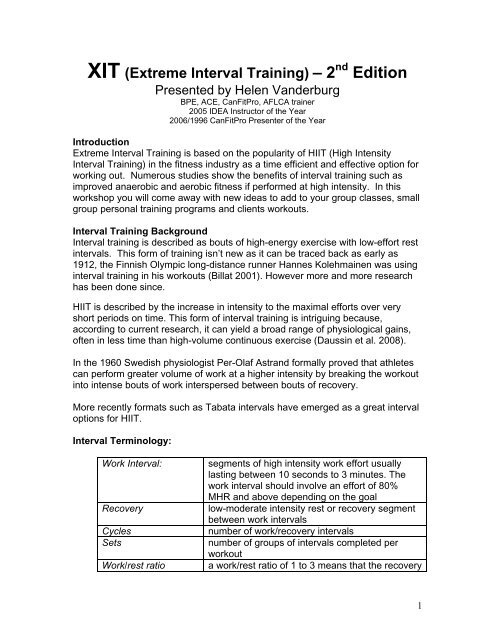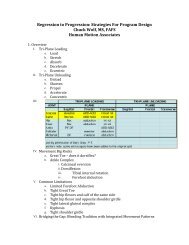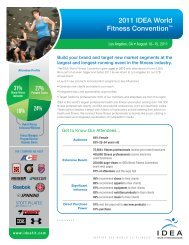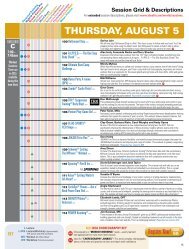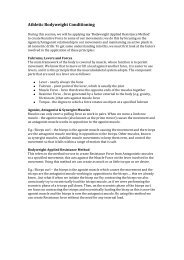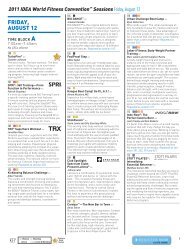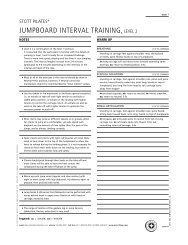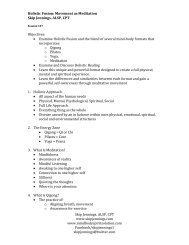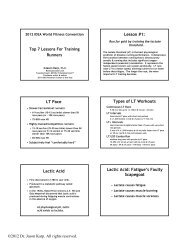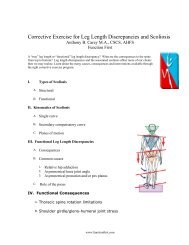XIT (Extreme Interval Training) - Idea
XIT (Extreme Interval Training) - Idea
XIT (Extreme Interval Training) - Idea
You also want an ePaper? Increase the reach of your titles
YUMPU automatically turns print PDFs into web optimized ePapers that Google loves.
<strong>XIT</strong> (<strong>Extreme</strong> <strong>Interval</strong> <strong>Training</strong>) – 2 nd Edition<br />
Presented by Helen Vanderburg<br />
BPE, ACE, CanFitPro, AFLCA trainer<br />
2005 IDEA Instructor of the Year<br />
2006/1996 CanFitPro Presenter of the Year<br />
Introduction<br />
<strong>Extreme</strong> <strong>Interval</strong> <strong>Training</strong> is based on the popularity of HIIT (High Intensity<br />
<strong>Interval</strong> <strong>Training</strong>) in the fitness industry as a time efficient and effective option for<br />
working out. Numerous studies show the benefits of interval training such as<br />
improved anaerobic and aerobic fitness if performed at high intensity. In this<br />
workshop you will come away with new ideas to add to your group classes, small<br />
group personal training programs and clients workouts.<br />
<strong>Interval</strong> <strong>Training</strong> Background<br />
<strong>Interval</strong> training is described as bouts of high-energy exercise with low-effort rest<br />
intervals. This form of training isn’t new as it can be traced back as early as<br />
1912, the Finnish Olympic long-distance runner Hannes Kolehmainen was using<br />
interval training in his workouts (Billat 2001). However more and more research<br />
has been done since.<br />
HIIT is described by the increase in intensity to the maximal efforts over very<br />
short periods on time. This form of interval training is intriguing because,<br />
according to current research, it can yield a broad range of physiological gains,<br />
often in less time than high-volume continuous exercise (Daussin et al. 2008).<br />
In the 1960 Swedish physiologist Per-Olaf Astrand formally proved that athletes<br />
can perform greater volume of work at a higher intensity by breaking the workout<br />
into intense bouts of work interspersed between bouts of recovery.<br />
More recently formats such as Tabata intervals have emerged as a great interval<br />
options for HIIT.<br />
<strong>Interval</strong> Terminology:<br />
Work <strong>Interval</strong>:<br />
Recovery<br />
Cycles<br />
Sets<br />
Work/rest ratio<br />
segments of high intensity work effort usually<br />
lasting between 10 seconds to 3 minutes. The<br />
work interval should involve an effort of 80%<br />
MHR and above depending on the goal<br />
low-moderate intensity rest or recovery segment<br />
between work intervals<br />
number of work/recovery intervals<br />
number of groups of intervals completed per<br />
workout<br />
a work/rest ratio of 1 to 3 means that the recovery<br />
1
period is three times as long as the work interval.<br />
For instance: a 1-minute work interval of high<br />
intensity followed by a relief interval of light<br />
jogging for 3 minutes has a 1:3 work to rest ratio<br />
Designing <strong>Interval</strong> <strong>Training</strong> Workout – 4 variables:<br />
1. Work <strong>Interval</strong> Time (or distance)<br />
2. Intensity<br />
3. Recovery <strong>Interval</strong> Time<br />
4. Number of Repetitions<br />
<strong>Interval</strong> <strong>Training</strong> Guidelines<br />
Energy system Work time Cycles Work/relief Type of recovery<br />
Anaerobic Power<br />
<strong>Interval</strong><br />
ATP-Pc 0-30 sec 1-8 1/3 Passive<br />
Anaerobic Capacity<br />
<strong>Interval</strong><br />
Lactic Acid 30-60 sec 1-5 1/3 Passive or Active<br />
Lactic Acid 60-120 sec 2-3 1/2 Passive or Active<br />
Aerobic <strong>Interval</strong>s<br />
Oxidative 2-3 mins 4-6 1/2 (or less) Active<br />
Oxidative 3-5 mins 3-6 1/2 (or less) Active<br />
Adapted from Kravitz, L., The Fitness professionals guide to Circuits and <strong>Interval</strong>s, www.drlendravitz.com<br />
HIIT <strong>Interval</strong> Design<br />
- consideration the duration, intensity and frequency of the high-effort (or “work”)<br />
interval; and the length of the recovery (or “rest”) interval.<br />
- work interval can last from 5 seconds to 8 minutes. Power athletes tend to<br />
perform shorter work intervals (5–30 seconds), while endurance athletes will<br />
have longer work intervals (30 seconds to 8 minutes) (Kubukeli, Noakes &<br />
Dennis 2002).<br />
- Intensity of the work interval should range from 80% to more than 100% of<br />
maximal oxygen consumption (VO2max), HR max or maximal power output.<br />
- intensity of the rest interval can range from passive recovery to active recovery<br />
of about 50%–70% of the intensity measures described above<br />
2
Sample <strong>Interval</strong> Variations<br />
Extensive – not enough recovery for each interval<br />
Intensive – enough recovery for each interval<br />
Fartlek – random work and recovery phases<br />
Pyramid (ascending or descending)<br />
Ladder (ascending or descending)<br />
Warm up – 5-7 minutes<br />
<strong>Extreme</strong> <strong>Interval</strong> <strong>Training</strong> Sample Class<br />
Set 1: Aerobic Pyramid <strong>Interval</strong>s (9 minutes)<br />
1, 1.5, 2, 1.5, 1 minutes of work with 30 seconds of active recover between<br />
Exercises selection:<br />
4 long jumps forward with runs back<br />
Right leg ascending repeater knee<br />
Shuffle side with squats (jumps)<br />
Left leg ascending repeater knee<br />
Lunge to ski (4/2/1)<br />
Set 2: Anaerobic Power <strong>Interval</strong> (4 minutes)<br />
Tabata inspired (20/10 seconds 8 cycles)<br />
Burpee variation<br />
Squat jump variation<br />
Lateral jumps<br />
Plank variation<br />
Set 3: Anaerobic Capacity <strong>Interval</strong> (8 minutes)<br />
Pyramid training (recovery during partner exercise)<br />
Partner exercises<br />
15 sec. Vertical partner push ups<br />
30 sec. Human bench jump over<br />
45 sec. Crawl under<br />
60 sec. Partner squats<br />
45 sec. Crawl under<br />
30 sec. Human bench jump over<br />
15 sec. Vertical partner push ups<br />
Set 4: Fartlek (5 minutes)<br />
Random interval sets<br />
Partner walking lunges (tubing)<br />
Partner lunge and twist (tubing)<br />
Partner resisted lunges (tubing)<br />
Partner resisted runs (tubing)<br />
3
Set 5: Group Strength Challenge (AMRAP in 5 minutes)<br />
(10 reps each)<br />
Rock and Roll Push ups<br />
Knee tucks<br />
Plank jacks<br />
Touch down jacks<br />
Set 6: Partner Work (4 minutes)<br />
(1:00 min each)<br />
Partner pull ups<br />
Plank arm wrestle/ shuffle<br />
Abs curl high 5/ crab crawl<br />
Cool down and stretch<br />
Presented by Helen Vanderburg<br />
www.helenvanderburg.com www.fusion-fitness-fitness.com follow me on<br />
Resources<br />
Kravitz, L., The fitness professionals guide to Circuits and <strong>Interval</strong>s.<br />
www.drlendravitz.com/articles<br />
Smith, Mark, Sprint <strong>Interval</strong> <strong>Training</strong> -“It’s a HIIT”, Research Paper, 2008<br />
Tabata et al., Effects of moderate-intensity endurance; high-intensity on anaerobic<br />
capacity and VO2 max, Med. Science Sports Exercise 1996<br />
Zulz M., Kravitz L., A look at the science of high-intensity interval training, IDEA<br />
Fitness Journal, February 2012<br />
4


